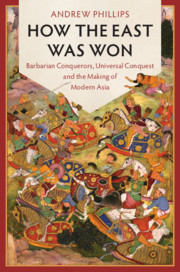Book contents
- How the East Was Won
- LSE International Studies
- How the East Was Won
- Copyright page
- Dedication
- Contents
- Maps
- Preface and Acknowledgements
- Introduction
- 1 From the Rise of the West to How the East Was Won
- 2 The Eurasian Transformation
- 3 The Rise of Asia’s Terrestrial Empires
- 4 European Infiltration and Asian Consolidation in Maritime Asia, 1600–1700
- 5 The Great Asian Divergence
- 6 The East India Company and the Rise of British India, 1740–1820
- 7 Crises of Empire and the Reconstitution of International Orders in South and East Asia, 1820–1880
- Conclusion
- References
- Index
3 - The Rise of Asia’s Terrestrial Empires
Published online by Cambridge University Press: 01 October 2021
- How the East Was Won
- LSE International Studies
- How the East Was Won
- Copyright page
- Dedication
- Contents
- Maps
- Preface and Acknowledgements
- Introduction
- 1 From the Rise of the West to How the East Was Won
- 2 The Eurasian Transformation
- 3 The Rise of Asia’s Terrestrial Empires
- 4 European Infiltration and Asian Consolidation in Maritime Asia, 1600–1700
- 5 The Great Asian Divergence
- 6 The East India Company and the Rise of British India, 1740–1820
- 7 Crises of Empire and the Reconstitution of International Orders in South and East Asia, 1820–1880
- Conclusion
- References
- Index
Summary
This chapter examines the rise of the Mughal and Qing empires, which together forged a template for rule that would define Asian and Western approaches to empire in the Old World down to the twentieth century. Mughal and Manchu conquest elites succeeded in establishing and maintaining rule over vastly more prosperous, populous and culturally sophisticated subject populations during the early modern era. They did so through strategies of define and conquer and define and rule, entailing the extensive customization and repurposing of indigenous normative and institutional resources for imperial ends. Imperial elites creatively remixed these resources, both to create local constituencies in favour of ‘barbarian’ rule, and also to generate the coercive reserves of hard power needed to defend their empires from internal and external hard challenges. Finally, rulers in both empires then stabilized their power through the establishment of distinct diversity regimes, which institutionalized existing practices of define and rule, while blocking the potential rise of anti-imperial coalitions.
- Type
- Chapter
- Information
- How the East Was WonBarbarian Conquerors, Universal Conquest and the Making of Modern Asia, pp. 88 - 126Publisher: Cambridge University PressPrint publication year: 2021



